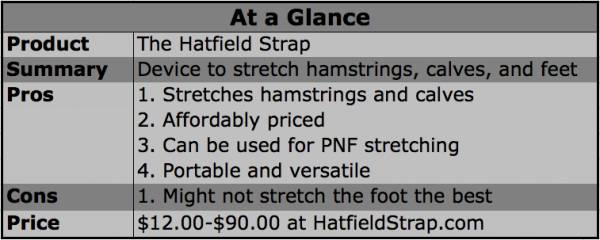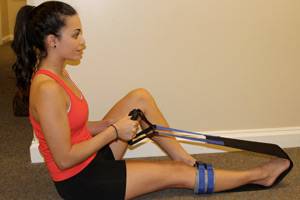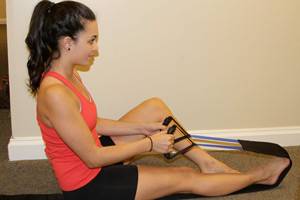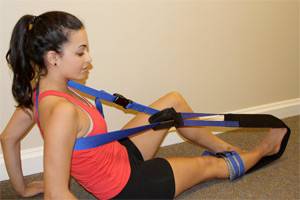

As someone who has suffered from plantar fasciitis, calf pain, and Achilles problems for years, I was intrigued to learn about the Hatfield Strap.
Over the years I’ve tried a lot of different tactics and devices, almost all of which had zero benefit for my chronic lower leg issues. I even wore the crazy boot-strap contraption at night, which wound up doing nothing except making my toes go numb, and I eventually learned how to dismantle it in my sleep anyway.
The only thing I found that worked was a diligent routine of stretching and foam rolling. So it was interesting to discover that Keith Hatfield, former athletic trainer for the Kansas City Royals, had a similar experience. Only he used the opportunity to invent a new device to solve his dilemma. Hence, the creation of the Hatfield Strap.
I was sent all three products that Hatfield produces: the calf strap, sit strap, and shoulder strap.
Calf Strap
The original device invented by Hatfield, the calf strap fastens around your calf (duh) with adjustable straps and plastic clips. The inside of this portion of the calf strap is also lined with a grippy strip to help prevent it from sliding down your leg.

From there, a long, wide piece of fabric runs down your leg, along the bottom of your foot. The fabric comes around the top of your toes, so that you can grab the attached handles and pull to your heart’s delight.
The handles are attached to the corners of the fabric so you can pull your whole foot back, and not just yank on certain toes. The handles themselves are surprisingly comfortable to grip, reminiscent of a nice piece of suspension equipment.
The calf strap comes in three sizes, based around your calf measurement at its largest point:
- Small – 10-14”
- Medium – 14-21”
- Large – 22-30”
Sit Strap
The design of this one is much simpler. It’s basically one long piece of material with handles attached to one end. It has the same handle design and placement as the calf strap. It also utilizes the same grippy strip to the gear from sliding, but this time you are sitting on the strip.
The advantage to the sit strap over the calf strap is that you can simply sit forward or back on the strap to adjust how long the pulling straps are.
Unlike the calf strap, which has to fasten at the strap, if I want my arms to pull closer or further, I can move myself to make that adjustment. With the calf straps, you’re stuck with the strap length you’ve got.
For this reason, I found the sit strap more comfortable to use because I didn’t feel like I was mid-row the entire time I was stretching. In addition, this one would be useful for people of various sizes, so it would be good for a whole household or to keep at a gym for clients.

Shoulder Strap
This add-on is simply an adjustable loop of fabric with a large plastic clip closure. But for those of us who need to hang out in our calf stretches for a long time, this is a brilliant little piece of fabric.
Once you fasten it and adjust the length, all you have to do is lean back a bit to apply the stretch to your leg and foot. I wouldn’t mind if the shoulder strap were a bit more comfortable, but considering it’s only $12.00, or even less if you purchase one of the combo sets, it’s not a big deal.

What It’s Like to Use the Hatfield Strap
With both the sit strap and the calf strap, I felt deep and rewarding calf and Achilles stretches. I also enjoyed the fact that the strap didn’t just yank back on my toe, like I would do to myself while attempting a seated forward fold or like the nighttime plantar fasciitis devices tend to do.
That being said, the design also potentially doesn’t stretch the arch of your foot in the same way that pulling on your foot yourself or using a strap horizontally across your foot might do.
Since my tightest points are my hamstrings, calves, and Achilles, this was not an issue for me (as I’ve not yet progressed to getting any sort of stretch to reach my feet!), but my husband (who has far more flexible legs than I do) noticed it immediately.
We deduced that this happens because the strap runs the length of your foot and doesn’t really have a way to bend your foot at any point other than your ankle. So the arch and the toes won’t get pulled apart the same way they might in other stretches.
The result of this has two aspects: it might occur to you that the strap doesn’t torture your feet as much, but it also might occur to you that it doesn’t spread your foot and toes apart as much as other approaches might.
Other Potential Benefits of the Hatfield Strap
If you’ve done PNF stretching, then you might find these Hatfield straps particularly useful. PNF stretching typically requires a partner, but you can provide enough resistance for yourself using these tools to do PNF stretching on your own.
Both devices can also be used to stretch the hamstrings, by sitting back and putting your leg straight up in the air. You can add in a stretch for your IT band by letting your leg cross your body.
Could you do all of these things with a piece of rope? Yes, in theory you could, but then you’d be back to being uncomfortable, trying to actively hold these stretches for any length of time. And to me, that is the biggest benefit of the Hatfield strap – it allows people who need to spend more time stretching to do so more easily.
Overall I found the construction of these straps impressive and the prices completely reasonable. If you are a personal trainer wanting to keep useful mobility devices on hand at your gym or you are an athlete with chronic hamstring, lower leg, or plantar fasciitis issues, then the Hatfield Strap might be something for you to investigate.






